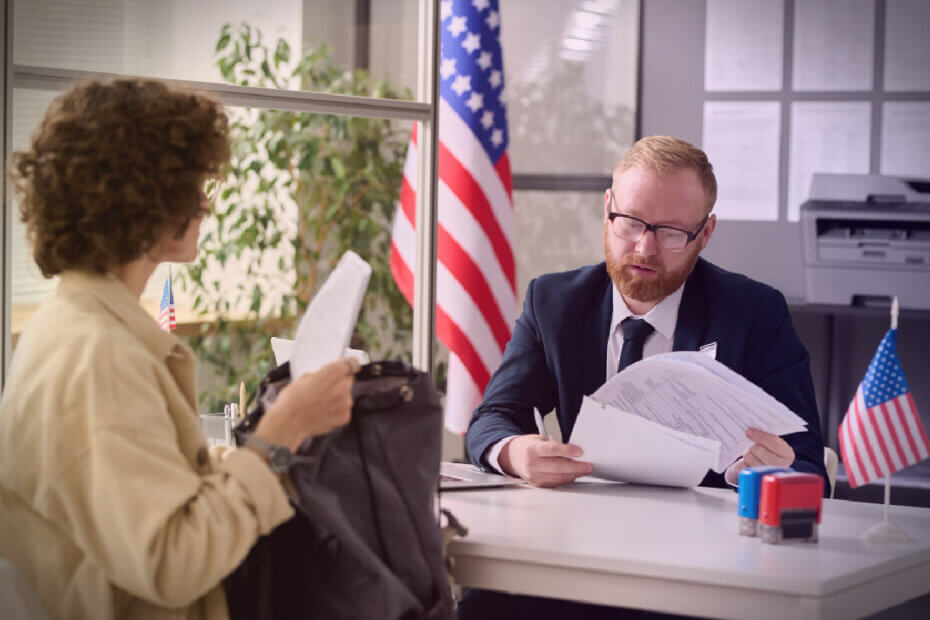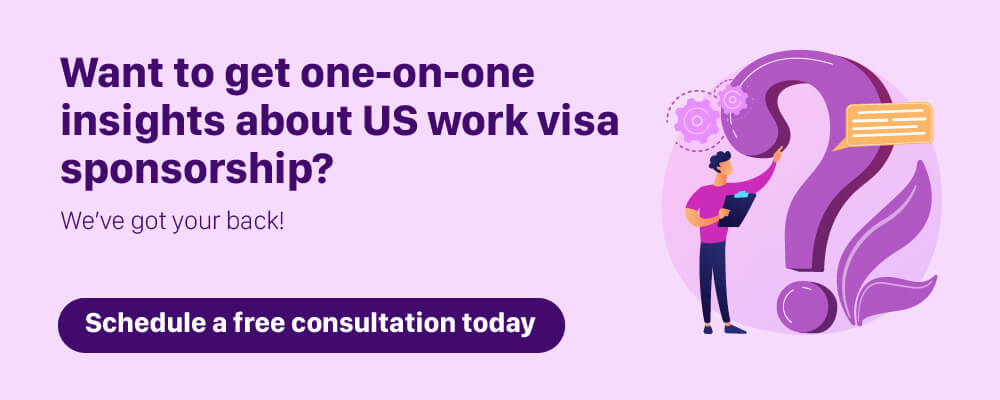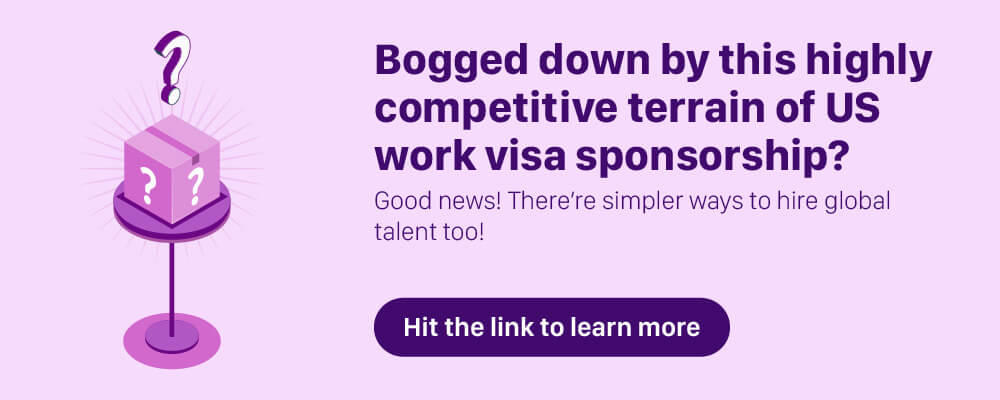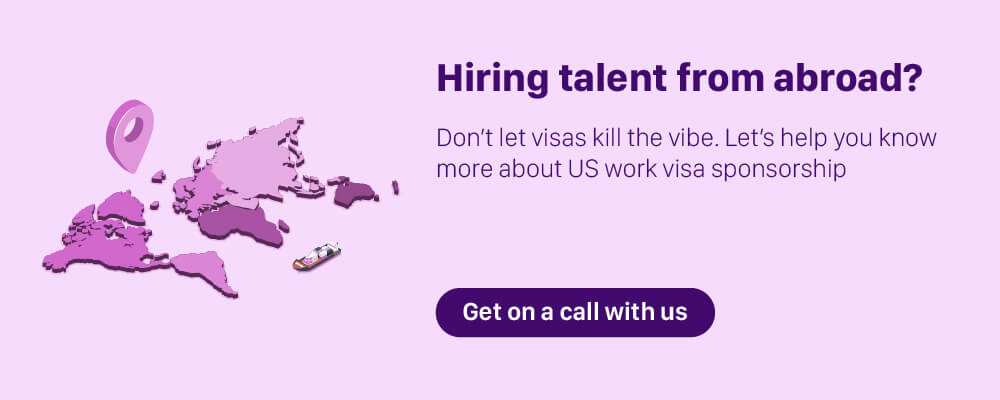Summary
US work visa sponsorship has a tight procedure. This includes the eligibility criteria for the candidates. The employers should also be prepared with the right documentation. However, once the process is done, it’s totally worth the effort. How? You get specialized talent from across the world!
Hiring globally does not mean bypassing domestic candidates. It means accessing specialized skills that give employers an extra edge. Hence, when the demand goes beyond local talent pools, US work visa sponsorship becomes a critical part of the recruitment process.
Also, in US work visa sponsorship, employers don’t just offer jobs. They take care of immigration systems, compliance risks, and financial commitments. When done right, work visa USA sponsorship delivers long-term ROI through innovation, diversity, and loyalty from world-class talent.
This blog is our go-to guide for getting it right. Inside, we’ll cover:
-
- Why U.S. companies are actively sponsoring foreign workers
- Which visa types match different roles and industries
- How to meet sponsorship requirements as an employer
- What candidates must prepare to stay competitive
- The real costs behind the work visa USA sponsorship
Whether you’re a hiring manager or a hopeful applicant, this guide gives you clarity and confidence.
What Is a US Work Visa Sponsorship?
It’s the process where a U.S. employer helps a foreign professional get a work visa so they can legally live and work in the United States. It’s not just a job offer. It’s a formal petition to USCIS. Don’t worry, we’ll get to the jargon later in the blog.
The employer must prove you’re fit for the job and that no American worker can fill it. This is truly an exceptional opportunity for employees aiming to work in the U.S.
It mostly applies to visas like:
-
- H-1B: for specialized workers in popular industries.
- L-1: for internal company transfers.
- O-1: for individuals with extraordinary skills.
Here’s presenting you with some wild data. In 2024, over 780,000 people applied for just 85,000 H-1B spots. It’s scary and tempting at the same time.
With a US employment visa sponsorship, employers take on legal and sometimes financial duties. They’re putting their name and reputation on the line. That’s why work visa USA sponsorship is mostly offered for high-demand roles.
If you’re serious about a US work visa, here’s what you need to know:
-
- Find employers who actively offer US employment visa sponsorship
- Customize your resume for high-demand industries
- Be ready for tight deadlines and big competition
Without US work visa sponsorship, your shot at a US work visa is slim to none. In short, work visa USA sponsorship is potentially the easiest way to work for foreign companies.
Now let’s see what’s in there for employers in US employment visa sponsorship.
Why Are Employers Stepping Up for US Work Visa Sponsorship?
U.S. companies, both startups and giants, are racing to sponsor global talent. Why now? Because the demand for specialized skills is outpacing the local supply.
According to GoodReturns, Amazon alone filed over 13,000 LCAs in 2024. That’s no small feat. It’s a bold move that screams, “We need global brains!”
And this trend doesn’t end with tech giants. Startups are jumping in, too. Why? Simple. They can’t afford long hiring cycles or skill mismatches.
There are hundreds of posts made by modern-day startups on LinkedIn promoting a single thought! “Talent has no borders”. This mindset is shaping the future of hiring.
Learn more about global talent mobility here.
Why This Surge in US Work Visa Sponsorship?
-
- The U.S. is facing a serious tech talent crunch, especially in AI, data, and cybersecurity.
- Startups need niche expertise to scale fast. Global hires fill that gap quickly.
- Big players use US employment visa sponsorship to stay ahead in global innovation.
- Work visa USA sponsorship offers a clear path to bring in talent without delays.
To add more to it, some visa policies have softened, allowing for quicker hiring decisions. Employers are reading the room and making strategic use of US employment visa sponsorship.
Even amid debates on immigration, companies know that US employment visa sponsorship is less risk, more return.
Whether you’re a billion-dollar tech firm or a seed-stage startup, the goal for US employment visa sponsorship is the same.
Now, let’s get into the types of US work visa sponsorship.
Types of US Work Visa Sponsorship
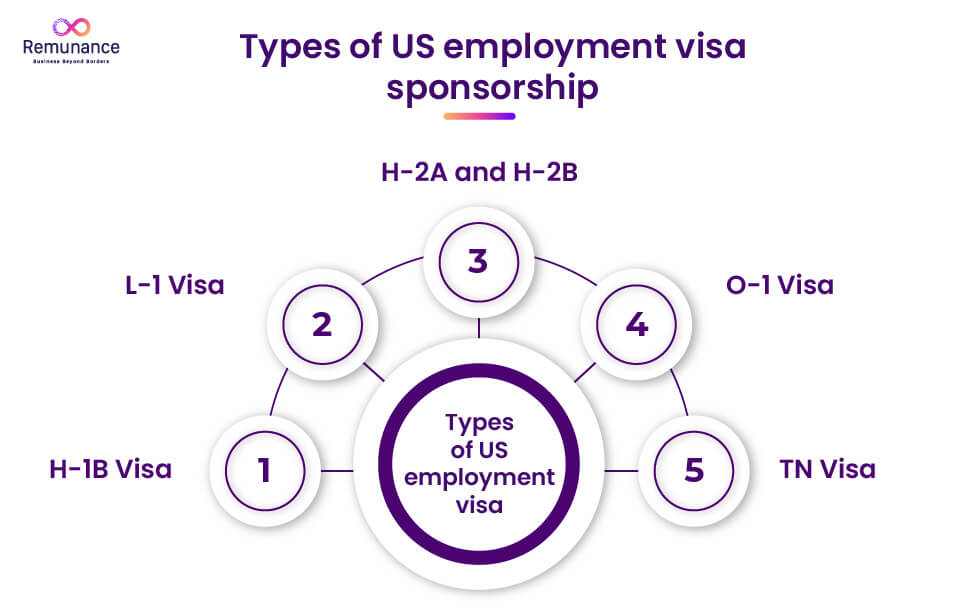
By now, we’ve established the fact that hiring global talent is a smart move. But if you’re bringing them to the U.S., you’ve got homework. Yes, I’m talking about a work visa USA sponsorship.
Each work visa sponsorship USA route has its own rules, timelines, and paperwork. As an employer, knowing the right fit saves time and avoids legal complications.
H-1B Visa
This visa is for high-skilled talent and is in high demand. The H-1B visa is ideal for skilled roles like tech, finance, healthcare, and engineering. However, with competition being high for this type of visa, you need to stay cautious about a few things:
-
- The candidates need to have a bachelor’s degree or equivalent.
- The visa requires a Labor Condition Application (LCA) from the Department of Labor (DOL).
- This type of visa now faces tougher rules against duplicate registrations.
Hence, with this type of US employment visa sponsorship, you need to plan early (preferrably at least 4 months prior) and document everything.
L-1 Visa
As mentioned earlier, this visa is to transfer top talent within the company. Need to move key staff from a global office? The L-1 visa is your ally. Its typical features are:
-
- L-1A is for managers and execs.
- L-1B covers specialized knowledge roles.
- No annual cap, but increased scrutiny post-COVID.
Use this work visa sponsorship USA to build your U.S. leadership bench fast and efficiently.
H-2A and H-2B
This visa is for seasonal and hard-to-fill jobs. Running operations in farming, landscaping, or hospitality? These visas bridge critical labor gaps. Let’s see these visa details:
-
- H-2A: Agricultural jobs.
- H-2B: Seasonal non-agricultural roles.
- DOL now enforces stricter wage and shortage verification rules.
O-1 Visa
This visa brings in the best of the best. Hiring a genius, award-winner, or world-class creator? The O-1 visa is your answer. Its typical features are:
-
- Used by startups, labs, and creative firms.
- Fast-track option for global standouts.
This work visa USA sponsorship goes by the saying, “Hire stars, not resumes.”
TN Visa
It’s a shortcut for Canadian & Mexican talent. Under the United States-Mexico-Canada Agreement (USMCA), the TN visa is a smooth option for North American Free Trade Agreement (NAFTA) neighbors. Its typical features are:
-
- No annual cap.
- Covers fields like science, education, and healthcare.
- Super-fast processing.
If you’re hiring regionally, this US employment visa sponsorship proves to be a blessing for you.
What Are the Eligibility Criteria for a US Work Visa Sponsorship?
To offer US work visa sponsorship, you must prove the job, your company, and the candidate’s qualifications.
Let’s walk through what you need to know to offer work visa USA sponsorship.
Skills and Education Requirements
This means the role should require at least a bachelor’s degree and the degree must align directly with the job field. If the degree is foreign, it needs a U.S. equivalency evaluation.
You Must Meet Sponsorship Obligations
Offer the prevailing wage based on job title and location and ensure hiring won’t impact existing U.S. workers.
Your Candidate Must Be Eligible
This means having no criminal or immigration issues, clear education and work history, and supporting documents like transcripts, credentials, and licenses (if needed).
You’re responsible for verifying these before starting US employment visa sponsorship.
Now, let’s see what the key steps are for employers before they offer work visa USA sponsorship.
You can also hire global independent contractors if your goals are short-term and you want to avoid the lengthy process of work visa sponsorship USA.
What Are the Key Steps for Employers in a US Work Visa Sponsorship?
Here’s what employers need to know beyond the basics while offering a work sponsorship visa USA.
1. Plan Early for Cap-Subject Visas
Failing to plan is planning to fail. This rings true for US employment visa sponsorship. Here are a few mandatory things to keep in mind:
-
- H-1B cap opens in April, but prep starts months before.
- Review roles, identify candidates, and align timelines.
- Miss the window, and you’re waiting a full year.
2. Structure Job Titles and Duties Carefully
One wrong job title can throw everything off.
-
- USCIS (U.S. Citizenship and Immigration Services) checks if the degree matches the role.
- Use O*NET codes to show relevance clearly.
- Don’t leave room for grey areas in job duties and responsibilities.
This step can make or break a work visa USA sponsorship petition.
An added tip. You can leverage these global employment platforms to post your job and find candidates easily.
3. Factor in Green Card Intent Early
Many employers lose good talent by waiting too long.
-
- Start green card discussions during onboarding.
- Show you’re invested in their long-term future.
- It boosts retention and saves future paperwork.
Strike while the iron is hot; timing is everything in US employment visa sponsorship.
4. Budget for Hidden Costs
Work visa sponsorship USA isn’t cheap—know the full cost before you commit.
-
- Expect to spend $10,000–$15,000 per employee.
- Include legal fees, premium processing, and relocation support.
5. Stay Audit-Ready with a Central System
Organize like a pro.
-
- Track visa dates and compliance docs in one place.
- Be ready with increasing DOL audits for US work visa sponsorship.
- One missing form can lead all your work sponsorship visa USA efforts to vain.
Costs Involved in the US Work Visa Sponsorship
US work visa sponsorship comes with costs that are beyond financial. If you’re planning to sponsor someone, know what you’re signing up for.
Let’s start with the basics. The H-1B visa, one of the most common US work visas, has a $460 filing fee. That’s just the first step. You’ll also pay a training fee of around $750 if your company has 25 or fewer employees. The fees go up to $1,500 if you’ve got more.
Then there’s the $500 anti-fraud fee. If your company has 50+ employees and more than half are already on H-1B or L-1 visas, you’ll owe an additional $4,000. That’s a hefty price for high-volume sponsors.
Most employers choose premium processing, which costs $2,805. However, it shaves months off the wait. It’s not required, but let’s be honest, time is money. No one likes waiting around in hiring limbo.
Now add legal help into the mix. Immigration attorneys typically charge $1,500–$4,000 per case. And that’s just the documentation side.
“Hiring the right people takes time, the right questions, and a healthy budget.” – Richard Branson
Breaking Down the True Investment
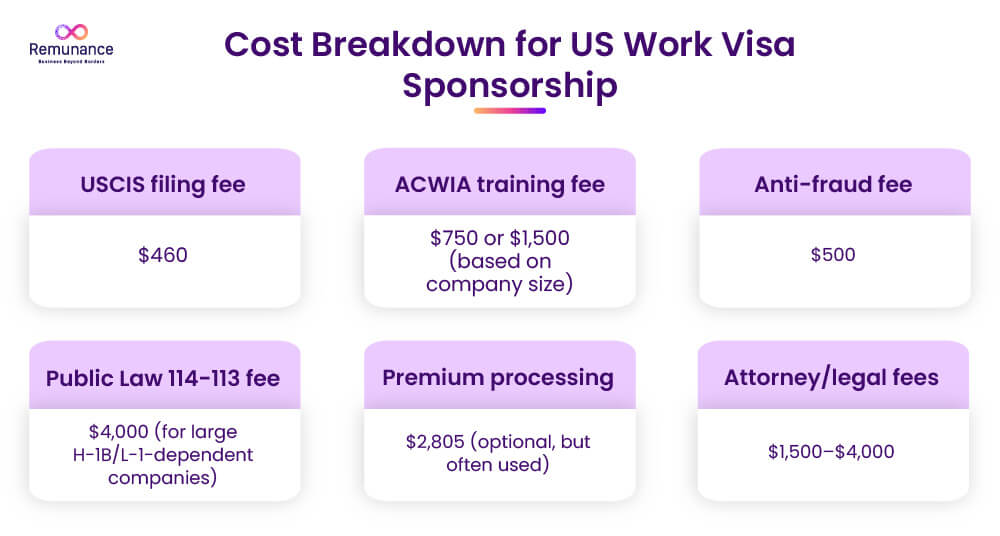
Here’s a clearer picture of where your money goes with a US employment visa sponsorship:
-
- USCIS filing fee: $460
- ACWIA training fee: $750 or $1,500 (based on company size)
- Anti-fraud fee: $500
- Public Law 114-113 fee: $4,000 (for large H-1B/L-1-dependent companies)
- Premium processing: $2,805 (optional, but often used)
- Attorney/legal fees: $1,500–$4,000
But remember, these are just upfront costs. Work visa sponsorship USA also involves compliance, recordkeeping, and sometimes relocation assistance. If things go long-term, you’ll also face extension and green card processing fees later.
You can consider it a down payment on future talent.
Why US Work Visa Sponsorship Still Makes Business Sense?
Yes, it’s a big spend. But it’s often a smart one. According to the National Foundation for American Policy, over half (55%) of U.S. tech startups valued at $1B or more were founded by immigrants.
That’s not a coincidence. The return on global talent is real.
US work visa sponsorship helps companies stay competitive, especially in fields where local talent may be scarce.
Conclusion
As we come to the end of the blog, let’s summarize a few things. Choosing the right US work visa sponsorship depends on the role, background, and urgency. You should always keep in mind “Right hire, right route”.
Whether it’s a US employment visa sponsorship for a specialist or work visa USA sponsorship for seasonal help, know the rules, stay compliant, and think long term. That way, you can make your US employment visa sponsorship truly worth it.

FAQs
Does hiring foreign talent mean ignoring local candidates?
Not at all. You’re not replacing anyone. You’re just adding skills you can’t find nearby. Sometimes, the best fit isn’t in your zip code, and that’s okay.
Why do companies even bother with sponsorship?
Because it works. Sure, there’s paperwork. But in return, you get top talent, fresh ideas, and loyal employees. For many, it’s worth every step.
How much does work visa sponsorship really cost?
Usually between $10K to $15K. That covers fees, lawyers, maybe some relocation. Yes, it’s a chunk of change. But if you find the right person? It pays off big time.
Can candidates apply for U.S. work visas on their own?
Most can’t. They need a company to sponsor them. That’s you. There are a few exceptions, but they’re rare. By that, I mean a Nobel Prize rare.
What’s the biggest mistake companies make here?
Waiting too long. Deadlines sneak up fast. There are caps and cutoffs. If you wait, you could miss your shot. Start early and avoid the panic.
